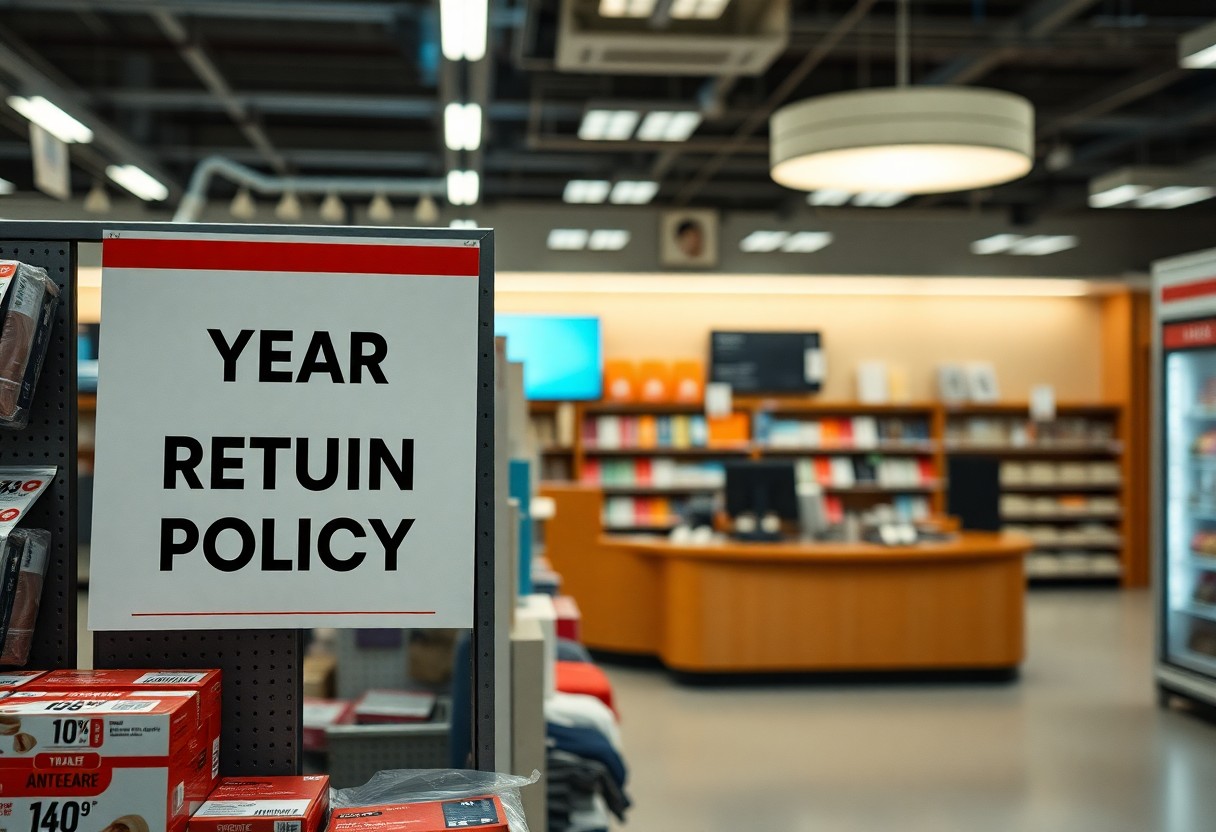Just as you plan your purchases, understanding the Target return policy can enhance your shopping experience. You have up to one year to return most items, giving you the chance to assess your purchases for quality and satisfaction. However, be aware that some items, like electronics, may have specific guidelines or restocking fees. Ensuring that your items are within the return window and in acceptable condition can lead to a hassle-free return process, allowing you to make the most of Target’s customer-friendly approach to returns.

The Rationale Behind a One-Year Return Policy
Analyzing Customer Expectations in Retail
In today’s retail landscape, customers seek assurance when making purchases, especially for significant investments. A one-year return policy responds to this demand by providing an extended window for decision-making, allowing you to thoroughly assess your purchase. This approach mitigates buyer’s remorse and can lead to increased customer satisfaction, fostering loyalty and repeat business. Surveys indicate that over 70% of consumers prefer retailers that offer flexible return windows, viewing it as a testament to the brand’s confidence in its products.
A long return policy aligns with modern shopping habits, where you may prioritize convenience and peace of mind. As online shopping continues to rise, the physical inability to try before buying enhances the appeal of generous return windows. A one-year timeframe gives you ample opportunity to test products in everyday situations, ensuring functionality and fit, which ultimately encourages you to make purchases without the fear of risk.
Examining Competitive Advantage in the Marketplace
Implementing a one-year return policy can serve as a pivotal differentiator in a crowded market. Such policies signal to you that the retailer is committed to customer service and product quality. Brands like Target have seen success with this strategy, strategically positioning themselves against competitors who offer less flexible options. You are more likely to choose a retailer that stands behind its products, viewing it as a reflection of quality and trust.
Retailers can also leverage a longer return policy to enhance their marketing efforts. Promotional campaigns can highlight the one-year return feature, attracting your attention and setting the brand apart. Enhanced trust often results in increased average order values, as you feel encouraged to buy more items knowing that returns are hassle-free.
The Customer Experience: Navigating Returns After a Year
Returns can often be daunting, especially after a significant period. However, understanding the process can alleviate stress and ensure a smooth experience. Target’s 1-year return policy provides flexibility, allowing you to return items within a reasonable timeframe if they don’t meet your expectations. You may find that even after a year, the process remains straightforward, provided you follow the established guidelines.
Step-by-Step Guide to Initiating a Return
| 1 | Gather your receipt or order confirmation if available. |
| 2 | Inspect the item for any damages or missing parts. |
| 3 | Visit the Target website or app to start the return process. |
| 4 | Choose your preferred return method: in-store or online shipping. |
| 5 | Follow the prompts to complete the return or print a shipping label. |
Despite the seemingly straightforward nature of returns, you might face several challenges. Missing receipts or unclear policies can complicate matters, leading to frustration. If you encounter issues verifying your purchase, reaching out to customer service promptly can help clarify your options. Be prepared to provide details such as purchase dates or item descriptions to expedite your case.
Common Challenges and How to Overcome Them
You may find that the most prevalent challenges revolve around timing and proof of purchase. Target emphasizes the need for original receipts or documentation, making it important to keep these safe. Additionally, item conditions play a significant role—items must be in their original state for smoother processing. Preparing ahead of your return trip can mitigate potential delays.
Another common issue occurs with shipping returns, particularly if you’ve lost the original packaging. Without it, complications can arise during the return process. Consider investing in durable shipping materials and keeping records of any tracking numbers you receive. This approach not only aids in managing your return but also serves as a reference if disputes arise regarding your item’s condition upon arrival.
Financial Implications for Retailers
Cost Analysis: Managing Returns Effectively
The financial burden associated with return policies, particularly one-year terms, can significantly impact your bottom line. An average return rate for retail can hover around 20% to 30%, depending on the sector. With a one-year policy, costs can escalate due to potential wear and tear on items, the logistics of handling returned products, and restocking fees. To mitigate these expenses, developing a clear return process and leveraging data analytics can provide insights into return patterns, allowing you to prepare and allocate resources effectively.
Implementing technologies like automated return processing systems can streamline handling and reduce labor costs. Moreover, offering clear guidelines on the condition of items eligible for return can discourage returns that are costly to manage. This proactive stance alters the perception of returns from an inevitable loss to a manageable aspect of your business strategy.
Impact on Inventory Management and Pricing Strategies
Your inventory management will require adjustments to accommodate a one-year return policy. This policy can increase uncertainty regarding stock levels, necessitating more sophisticated forecasting models. Holding excess inventory to cover potential returns can tie up capital that could otherwise be employed in growth initiatives. Companies successfully navigate this by utilizing just-in-time inventory systems, allowing them to remain lean while adequately preparing for customer demands.
Pricing strategies also evolve under the weight of a generous return policy. You may consider implementing slightly higher initial prices to offset projected return costs or offer discounts on items marked as final sale to manage expectations. Bundling products or encouraging exchanges instead of straightforward returns can lead to a more positive revenue outcome.
Furthermore, examining the data around which products see higher return rates can inform your pricing strategy. For instance, if certain categories like clothing have a notorious return rate, setting competitive prices with larger margins could help balance the costs incurred through returns. Engaging customers in meaningful dialogue about the fit and satisfaction of products prior to purchase can also lead to fewer returns and a healthier inventory turnover.

The Future of Return Policies in Retail
Trends Influencing Return Policies and Consumer Behavior
Shifts in consumer expectations greatly impact return policies, particularly as you increasingly seek convenience and flexibility. Retailers are responding by implementing features like free return shipping and extended return windows, recognizing that a seamless return experience can enhance overall brand loyalty. For example, a 2022 study revealed that 79% of consumers prioritize return experiences when deciding where to shop, underscoring the necessity of aligning return policies with customer desires.
Additionally, the rise of e-commerce has transformed your shopping habits, as you now often purchase items online without the opportunity to physically evaluate them first. This dynamic has led retailers to adopt more lenient return policies, effectively fostering a sense of trust and satisfaction. Companies are leveraging technology, including AI and data analytics, to better predict return rates and tailor policies accordingly, ensuring that both your needs and business interests are addressed.
Predictions for the One-Year Return Policy Landscape
As retail evolves, the one-year return policy is likely to gain traction among more brands, particularly in sectors like fashion and electronics where purchase satisfaction is paramount. Analysts predict that by 2025, nearly 40% of retailers will adopt this kind of policy as a standard offering, encouraging you to make purchases without the fear of commitment. This shift could result in a significant increase in overall sales volume, as a longer return period often leads to higher conversion rates at checkout.
Moreover, a burgeoning focus on sustainability is expected to shape the one-year return policy outlook. Retailers may begin to balance extended return windows with incentives for responsible returns, such as recycling or donating unwanted items. This could align with your values, making ethical shopping a priority while enhancing your overall experience in the retail space.
Summing up
Considering all points, a one-year target return policy provides you with the flexibility and assurance you need as a consumer. This policy allows you to evaluate your purchase thoroughly, ensuring that it meets your expectations in terms of quality and functionality. By knowing you can return items within a year, you can shop with confidence, reducing the pressure to make hasty decisions.
In addition, such a return policy demonstrates the retailer’s commitment to customer satisfaction. It creates a strong incentive for you to make purchases, knowing that your rights as a consumer are recognized and respected. Ultimately, a one-year target return policy enhances your overall shopping experience, encouraging loyalty and building trust in the brand.
FAQ
Q: What is the target return policy for items purchased within one year?
A: The target return policy allows customers to return items purchased within one year for a full refund, provided they are in original condition and packaging. This includes products that are unused and with tags attached.
Q: Are there any exceptions to the one-year return policy?
A: Yes, certain items such as electronics, opened personal care products, and items marked as final sale may have different return policies. It’s advisable to check the specific return guidelines for these products at the time of purchase.
Q: How do I return an item within the one-year return period?
A: To return an item, you can do so in-store or by mailing it back. If returning by mail, make sure to include the original receipt and follow the instructions provided on the Target website for returns.